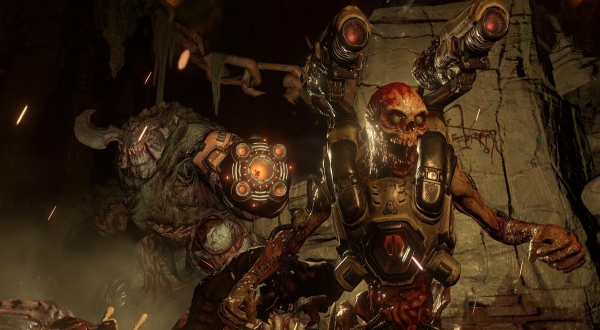Doom Has A Strategy To Fix A Major Problem With VR

One of the biggest problems facing a lot of virtual reality games is motion. Not just motion but motion sickness. Well, id Software may have come up with a solution for this problem in the form of a new method of moving. That may not make a lot of sense but it was explained at QuakeCon.
Gamespot managed to get in hands-on time with the upcoming Doom VR at this year's QuakeCon. The demonstration highlighted one important feature for the VR-themed re-release of the 2016 first-person shooter: traversal.
Unlike some other FPS titles out there, id Software decided to change the way players will move in Doom VR. Because the HTC Vive allows players to physically walk around a small virtual reality area, it needs a way to get players out of that box, into other parts of the virtual world. Most games do this with a sort of point and click interface. Press a button, look at the area you want to teleport into, then release the button, and blink, you're there. Doom VR has a new idea.
Apparently, it's a bullet-time teleportation system, where everything around you slows down and the Doom Guy quickly travels to his next destination at the near blink of an eye. This method is used to help give gamers some proper and decent movement options in Doom while using a VR headset like the HTC Vive. Since you still see yourself move to the new area, you have a better understanding of your bearings when you get there. Something that's very important in a fast paced shooter like Doom .
Zipping and zooming around the arena-style levels using teleportation is designed to get around this issue of moving through virtual space, however, it could also impact one of the other serious issues: motion sickness.
Even at 120fps, there are still people having difficulty physically adjusting to the motions in VR games. The first problem is that people like the Doom Guy don't move like real humans. So it creates a disparity when playing a game like Doom in VR because his motions aren't matching up to how you usually move, and what your eyes are seeing sends signals to your brain telling it that you are indeed in motion, even when you are not. What's more, is that since your body is mostly immobile, it's sending feedback to the brain saying that there's nothing going on here, calm down. The brain continues the feedback loop that you're moving because of what you're seeing through the HMD, and thus motion sickness occurs.
Now, some people have noted that they have acclimated their bodies to VR games using motion controls or a keyboard and mouse, and they were more-so concerned (and questioning) if it would be possible to play the new VR version of Doom without relying on the teleportation. Unfortunately, that info was not provided.
Your Daily Blend of Entertainment News
However, id Software is hoping that the teleportation will limit the amount of motion sickness that incurs from first-time VR users. Capcom ran into a similar problem with Resident Evil 7, where quite a few post-use reports indicated that after around 10 minutes of play they encountered motion sickness. Some people are calling it VR sickness.
Part of Resident Evil 7's issues came from the fact that the game had frame drops and stutter, causing it to dip below 60fps. Anything below 90fps in VR and you're risking major VR sickness. So Resident Evil 7 at E3 was a hotbed for problems.
For Doom, id Software is keeping the VR version relegated to high-end PCs and utilizing high-speed movement for traversal purposes. It's probably going to be the most efficient solution to the problem until peripherals like the Omni-Treadmill drop in price and become more widespread in use.
Staff Writer at CinemaBlend.

